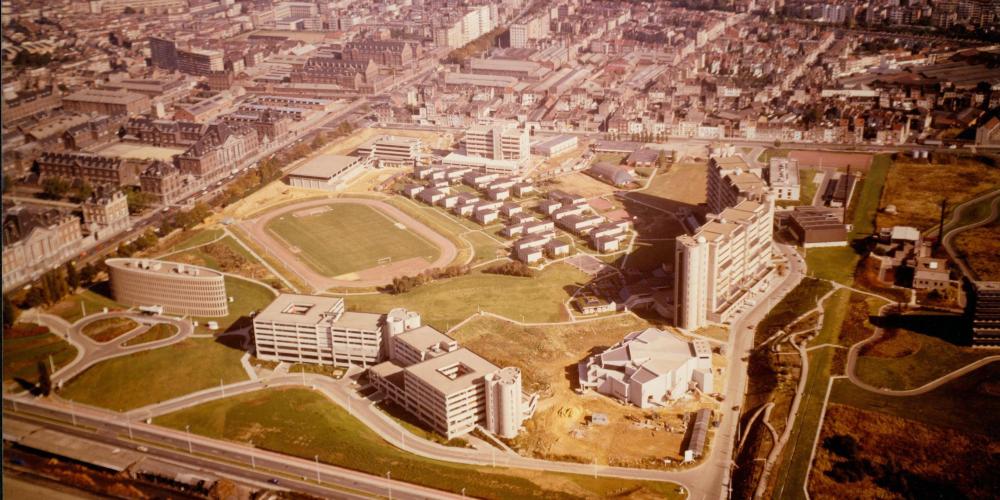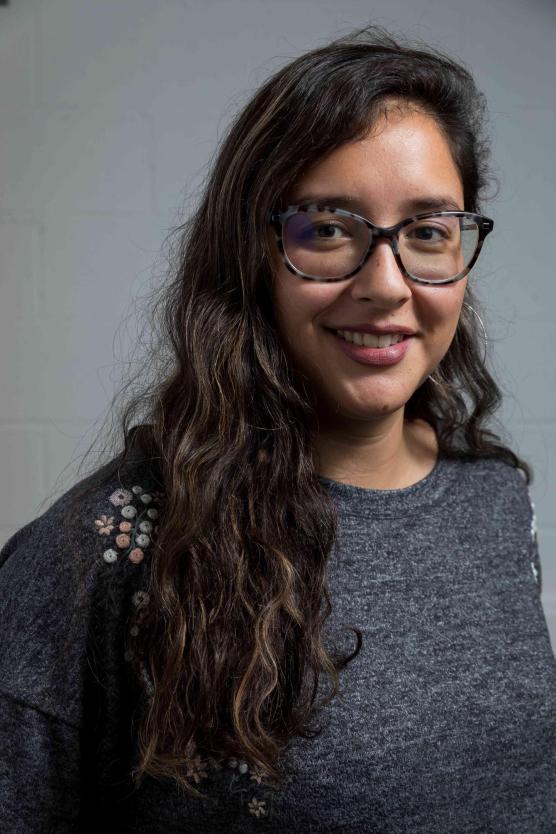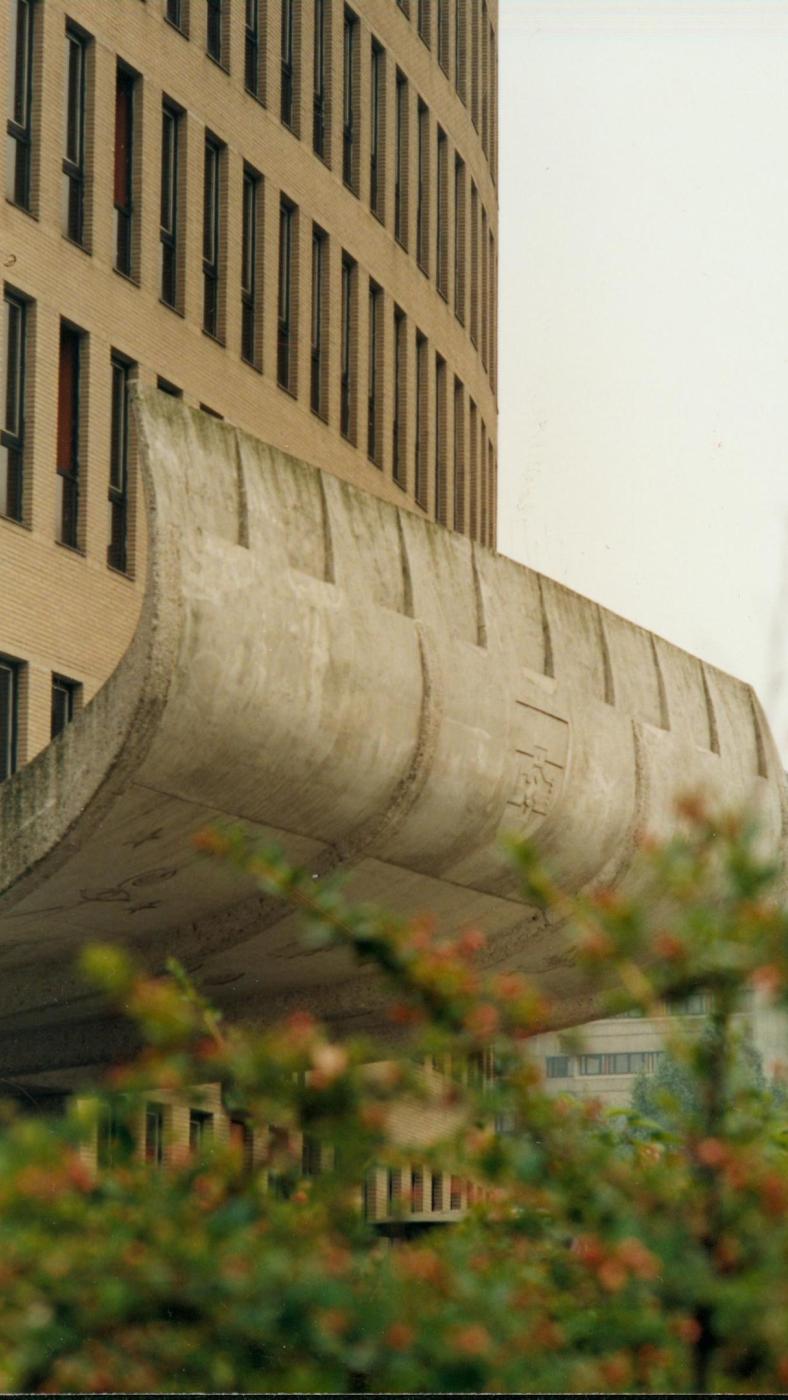
The green VUB campus in Etterbeek is not just a place where you can study, rent a dorm or play sports – it also has a particularly rich heritage. The Centre for Academic and Liberal Archives (CAVA) manages the VUB’s archives. Maria Mejia Sian, one of its employees, has created a guide to the historical architecture on campus. “The rector’s office building is a perfect architectural translation of the ideology of the VUB,” she says.
Heritage Day: the VUB as a second home
Sunday 21 April 2024 is Ergoeddag and CAVA is organising walks around student folklore on campus, a mini-expo on Willy Van Der Meeren's koten and student life at VUB and a scanning studio, where you can drop by with your old snapshots of life on campus to have them digitised.

Maria Mejia Sian
How did the story of the Etterbeek campus start?
Maria Mejia Sian: “After our university was established in 1969-1970, a new university campus was built on the former training grounds of the military barracks in Ixelles-Etterbeek. An international architecture competition was launched that yielded 217 proposals. The contract was awarded to French architect Noël Le Maresquier, whose idea was completely different from how the campus looks today. He wanted to link all the buildings in a kind of train module. The rotule of buildings F and G is his work, as are part of buildings B and C. But the university wasn’t really satisfied with the result, so the collaboration ended prematurely and VUB and ULB hired other architects.”
So, enter Willy Van Der Meeren, the designer of the legendary student rooms?
“That’s right. He was asked to build a student village in 1971 and then things moved very quickly. The first modules were built in January 1973, and barely 10 months later, students were moving in. Van Der Meeren was one of the first architects to use prefabricated materials, creating 352 student rooms on the campus – 100 for female students and 252 for male students. The colours – yellow, blue, red and later green – were meant to ensure that students could find their way faster. The extra corridors, paths and stairs were supposed to help with orientation, although according to tradition, they were actually intended for the police to get lost in the labyrinth! Van Der Meeren’s vision was in every way in keeping with the quirky, somewhat rebellious character that the university has always had. What few people know is that he also designed the social facilities on campus, including the iconic KultuurKaffee, now Bar Pilar.”
What happened to the student village afterwards?
“In 2016, it was decided that the campus needed a facelift, and many of the dorms were razed to make way for the renovated swimming pool. They initially wanted to get rid of all the units, but some were given a different use. Today, they house the Circular Retrofit Lab and the WVDM Living Lab, among other things. Additional research into the heritage value of the rooms has also begun. I suspect some of them will be preserved. You have to remember: Van Der Meeren was an architect of the people, he built for the masses, and in that respect too, the collaboration between him and the university was the right one.”
Another big name who shaped architecture on the VUB campus was Renaat Braem, wasn’t it?
“Exactly. He was commissioned in 1971 to design the rector’s office building, which was completed in the autumn of 1976. The building is every bit as iconic, not least because of its elliptical shape. For this reason, it’s sometimes called the Cigar or Caprice des Dieux, after the typical shape of the packaging of French cheese. In 2007, it was recognised as a monument by the Brussels Capital Region and 10 years later, during its renovation in 2018, it was officially named the Braem Building.”
To what extent does the Braem Building express the ideology of the VUB?
From the beginning, the architect wanted to make it a temple of wisdom, of science, of culture. The shape of the ellipse symbolises the dynamics of the newly founded VUB. In turn, the 720 windows refer to the transparency of the university. The concrete canopy is also very familiar. Some typical symbols are painted on it such as the university’s coat of arms: two hands holding each other, with a money pouch in the background, referring to the 16th-century noblemen who resisted the suppression of free thought. The same canopy also depicts torches, symbolising light in the darkness, surrounded by various elements of scientific research. The compass represents measurement, the eye seeing and the spiral understanding. It also features red deer and deciduous trees, and the three umbrellas one above the other are a critique of the administration’s policy.”
The murals inside also tell a story, don’t they?
“These illustrate, from the bottom to the top, the origins of the cosmos and the Earth, the origins of life and the development of plants, animals and humanity. These are murals spanning 500m that tell a continuous story. The higher you go in the building, the more the paintings show. And here too, darkness and ignorance are dispelled by the light of the torches. For a long time, these wall paintings were somewhat neglected and desks put in front of them, but today they are being renovated and given the attention they deserve. More than ever before, people realise that the rector’s office building symbolises the VUB’s ideology and values.”

Collection CAVA
Bio Maria Meija Sian
Maria Mejia Sian is archivist and public information officer at CAVA, which collects, preserves and manages the heritage and archives of the liberal humanist community in Flanders and Brussels and of the Vrije Universiteit Brussel.
The world needs you
This initiative is part of VUB's public programme, a programme for everyone who believes that scientific knowledge, critical thinking and dialogue are an important first step to create impact in the world.
As an Urban Engaged University, VUB aims to be a driver of change in the world. With our academic edcuational programmes and innovative research, we contribute to the Sustainable Development Goals of the United Nations and to making a difference locally and globally.